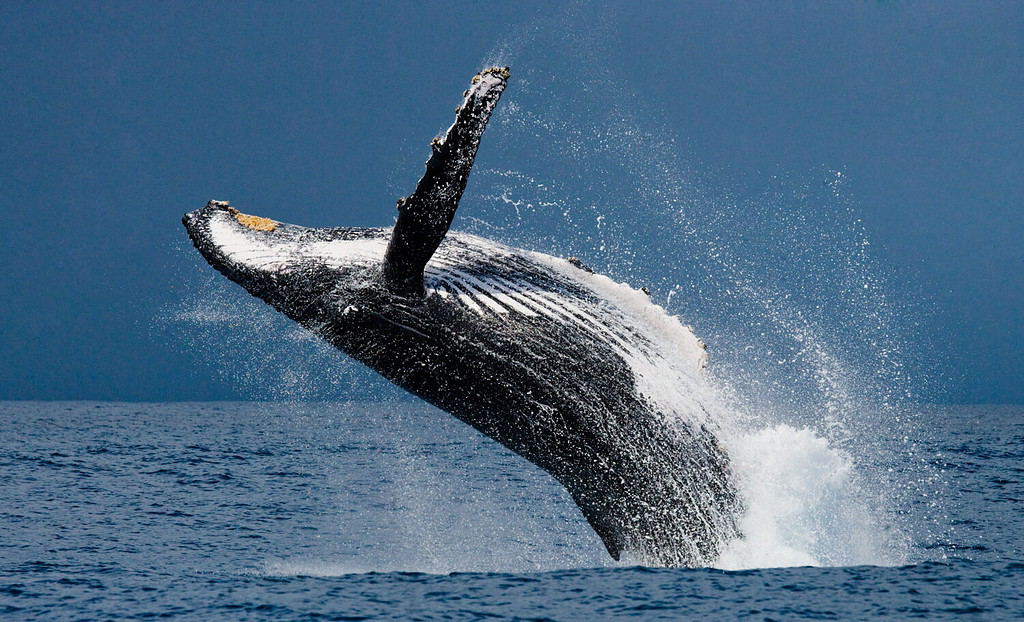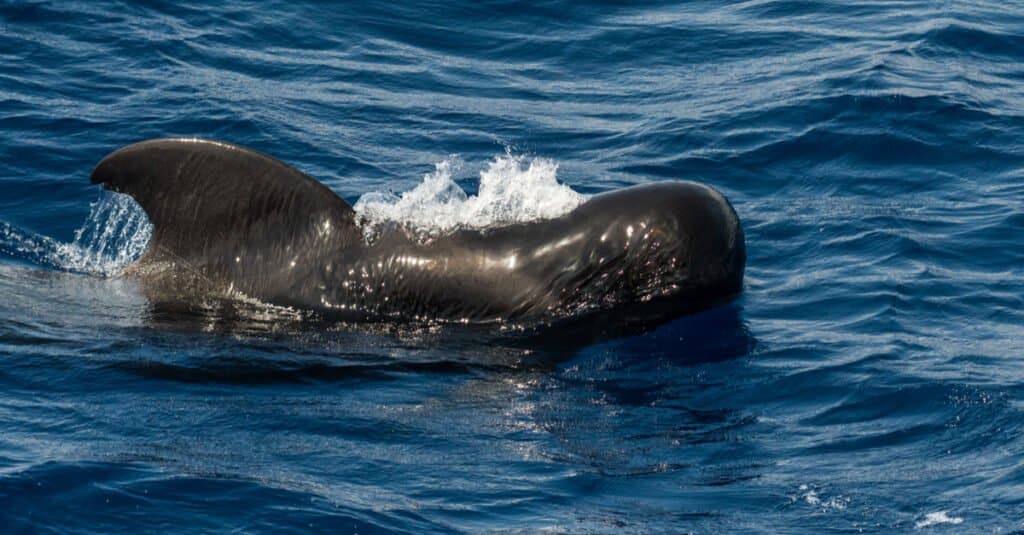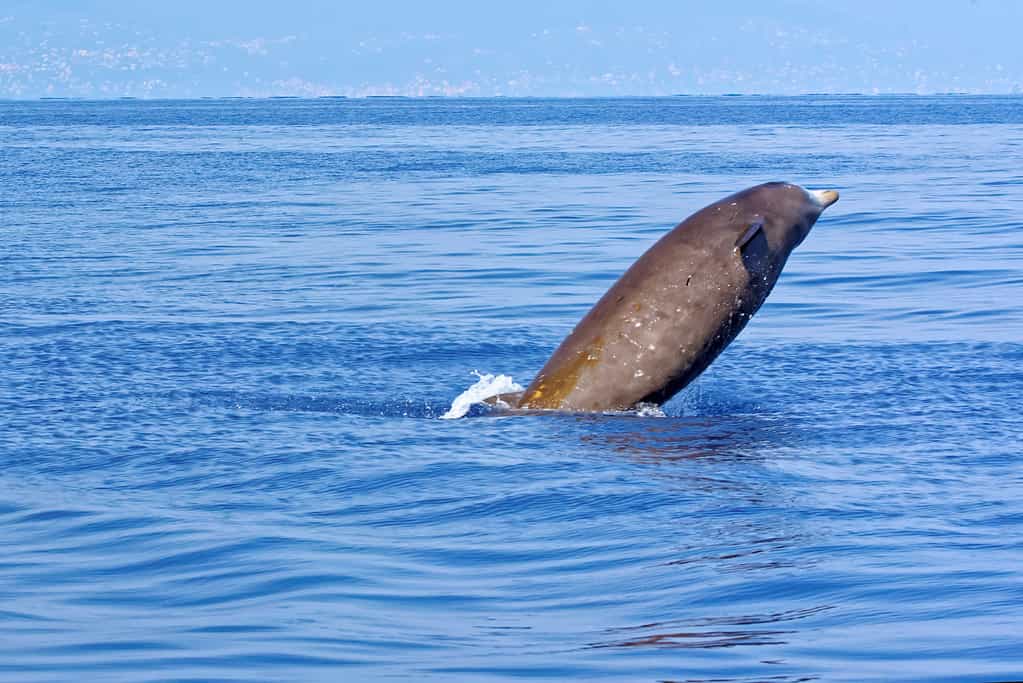Maui waters are perfect for whale spotting due to its crystal-clear waters and warm temperatures. These amazing waters invite many species of whales to call Maui home or simply pass through as a visitor. Whale watching in Maui is extremely popular and is an important tourist attraction in the area. The most common and popular whale to see here is the humpback whale. This incredible sight will leave you speechless and wanting more! So, if seeing a humpback whale is on your bucket list, go get yourself over to Maui!
Here are 7 types of whales you will find swimming in Maui waters, including humpback whales. We’ll also discuss the best time to see each type of whale.
Humpback Whale (Megaptera novaeangliae)

The most common whale species to spot in Maui is the humpback whale.
©GUDKOV ANDREY/Shutterstock.com
The humpback whale is the most common whale found in Maui waters. These whales are known for the complex, beautiful songs they make with their throats. The humpback whale is large and can grow between 48 and 62 feet in length and weigh up to 44 short tons. These whales are named for their hump near their dorsal fin. They are dark in color on their dorsal side and lighter in color on their ventral, or bottom, side. The head and jaw have hair follicles, and they have baleen plates instead of teeth. Furthermore, these amazing whales have a large pectoral fin around a third of the size of the body.
Humpback whales inhabit the shore of oceans and seas worldwide. These incredible whales undertake an epic migration, swimming up to 16,000 miles in a year. The diet of these whales consists mainly of plankton, fish, and krill. Incredibly, they can eat over 2,000 pounds of food each day! That’s a lot of plankton! They eat their prey by bubble netting in which they create a spiral of bubbles to trap their prey.
Every year, over 10,000 humpback whales migrate to the waters of Maui. This breathtaking sight can be seen from November through to May, with December to April being the best time to spot them.
Short-Finned Pilot Whale (Globicephala macrorhynchus)

Although not as common as humpback whales, the second-most common whale to spot in Maui is the short-finned pilot whale.
©Marcos del Mazo/Shutterstock.com
Short-finned pilot whales can also be found in Maui waters, although not as commonly as humpback whales. These whales are technically classified under the dolphin family, but scientifically speaking, all dolphins are whales. Short-finned pilot whales grow between 10 and 20 feet in length and weigh between 2,200 and 8,800 pounds or between 1 to 4 tons. Interestingly, short-finned pilot whales are actually the second-largest dolphin – second only to the killer whale! In terms of appearance, these whales have a stocky build and are black, dark gray, or brown in color. They also have a thick tailstock and a bulbous head. Their dorsal fin is broad and sickle-shaped.
Short-finned pilot whales can be found in coastal and pelagic waters in temperate and tropical regions of the Indian, Atlantic, and Pacific Oceans. The warm waters in their habitat provide lots of prey for these whales. Short-finned pilot whales are deep divers and are generally found foraging along the continental shelf break. They can feed at depths of up to 3,340 feet. Their diets generally consist of squid, but they’re not overly picky eaters, as they will also eat fish and octopus. To hunt, these whales use echolocation and attack with surprisingly high speed.
Short-finned pilot whales can be found in Maui waters in the summer months between May and October. They travel in tight-knit pods, which can make them easier to spot. However, with that said, these whales tend to spend most of their time in deep waters, so spotting one from shore is not overly likely!
Sperm Whale (Physeter macrocephalus)

You may be able to spot a sperm whale in Maui between March and May.
©Animalgraphy/Shutterstock.com
The sperm whale is the largest-toothed predator on Earth. These whales can grow between 36 and 59 feet in length and weigh between 35 and 55 tons. Sperm whales are known for their immense heads – in fact, their skulls make up a third of their skeletons, and their brain is the largest of any creature! The skin of these whales is typically dark gray in color and wrinkled behind the head. A fun fact about these whales is that they are unique in that they have only one asymmetrical blowhole on the left side of the head. The dorsal fins of the sperm whale are also small in size, and they have small, triangle-shaped flukes.
Sperm whales can be found all over the world, although they do tend to stay away from extremely cold waters. Females generally stay in temperate and tropical waters, while males travel in temperate waters. The diet of the sperm whale consists of sharks, skates, squid, and fish.
These whales frequent Maui waters and can be seen between March and May. During peak months, there is an estimated 7,000 sperm whales that visit these waters. However, because these whales stay in deeper waters, the likelihood of spotting one is quite low. Over 12 years of studies, only around 32 sperm whales have been sighted in the entirety of Hawaii. So, count yourself lucky if you manage to spot one in Maui!
False Killer Whale (Pseudorca crassidens)

Although false killer whales may look like orcas, they are two distinct whale species.
©Hawkeagle20/Shutterstock.com
Like orcas and short-filled pilot whales, false killer whales are also members of the dolphin family and are a relatively rare sight in Maui waters. As their name suggests, false killer whales look a bit like orcas. However, unlike orcas, these whales have a significantly smaller dorsal fin and a curved hump on the flippers. False killer whales are also black or dark gray with a white streak along the side. Their bodies are slender like other dolphins, and their heads are elongated and tapered. These whales can reach a length of up to 20 feet and weigh up to 3,000 to 4,000 pounds.
False killer whales can be found on every continent’s waters, except Antarctica. They prefer warm tropical waters, which means Maui waters make great homes for them. The diet of the false killer whale consists of squid, fish, and even marine mammals. They attack by catching the prey and swimming around at high speeds. They also shake the prey until they die and use their sharp teeth to peel off the skin. Talk about a gruesome death!
If you want a chance to encounter these amazing marine mammals, keep in mind that false killer whales can be spotted in Maui waters at any time of the year. They live in large pods, but they generally live in offshore waters. Besides humpbacks and pilot whales, false killer whales are the most common whales to see in Maui, but despite this, unfortunately, chances of actually seeing them are rare.
Melon-Headed Whale (Peponocephala electra)

A part of the dolphin family, the melon-headed whale may be difficult to spot in Maui.
The melon-headed whale is a toothed whale that is also part of the oceanic dolphin family. As its name suggests, the head of the whale is melon-shaped. These whales can grow up to 9 feet in length and weigh up to 500 pounds. They are dark gray in color and their bodies are slender. Melon-headed whales do not have a discernible beak and their dorsal fin is sickle-shaped.
Melon-headed whales inhabit tropical and subtropical oceanic waters. And their diet primarily consists of squid and small fish. They feed at night when their prey comes closer to the surface. Furthermore, these whales are an incredibly social species and are found in large pods of over 300 individuals and as many as 800 in some cases!
Unfortunately, although there are an estimated 3,000 melon-headed whales in Hawaii, spotting these whales in Maui waters is a rare event. But with that said, the best time to see them would be during whale season, which is between November and May.
Cuvier’s Beaked Whale (Ziphius cavirostris)

Yes, a beaked whale! The Cuvier’s beaked whale has a poorly defined beak.
©iStock.com/HeitiPaves
The Cuvier’s beaked whale is also commonly known as goose-beaked whale and ziphius. These whales are robust and are generally dark gray in color except for their head, which is distinctly lighter. They can grow between 15 and 23 feet in length and weigh between 4,000 and 6,800 pounds. They are toothed whales, and males also develop two tusks. The head of these whales is short and blunt, with a sloping forehead. Furthermore, the Cuvier’s beaked whale’s beak is poorly defined and small.
Cuvier’s beaked whales are found in deep, offshore waters in tropical and temperate seas. Although there is little information on the diving and feeding behavior of these whales, there is evidence that these whales make coordinated foraging dives in small groups. They use suction to acquire prey, such as squid and fish, directly into their mouths. They also use echolocation to locate their prey.
Because Cuvier’s beaked whales are not found near the coast, spotting them is extremely rare. The best time to try to spot these whales will be during the whale season in Maui between November and May.
Killer Whale (Orcinus orca)

Although rare, you may be able to spot an orca in Maui!
©slowmotiongli/Shutterstock.com
Another whale you might find swimming in Maui waters is the killer whale or orca. These whales are the biggest members of the dolphin family, reaching sizes of up to 32 feet long and weighing more than 12,000 pounds! Killer whales are mostly black in color on the top side and have a white underside. Most notably, these whales boast white patches near their eyes. Interestingly, orcas have teeth that are as long as 4 inches!
Unfortunately, chances of actually spotting an orca in Maui are incredibly slim. However, since there is still a chance, you may be one of the lucky few to spot one! There have been precious few sightings of orcas over the years, but they do exist in and around the Hawaiian Islands, including Maui! For the best chance of spotting a killer whale, you’re more likely to spot one during the winter months of November to May, which also happens to be the whale season in Maui.
Summary of Types of Whales You’ll Find in Maui
| Whale | Scientific Name | Best Time to See in Maui |
|---|---|---|
| Humpback Whale | Megaptera novaeangliae | December to April |
| Short-Finned Pilot Whale | Globicephala macrorhynchus | May to October |
| Sperm Whale | Physeter macrocephalus | March to May |
| False Killer Whale | Pseudorca crassidens | Any time of the year |
| Melon-Headed Whale | Peponocephala electra | November to May |
| Cuvier’s Beaked Whale | Ziphius cavirostris | November to May |
| Killer Whale | Orcinus orca | November to May |
Thank you for reading! Have some feedback for us? Contact the AZ Animals editorial team.








